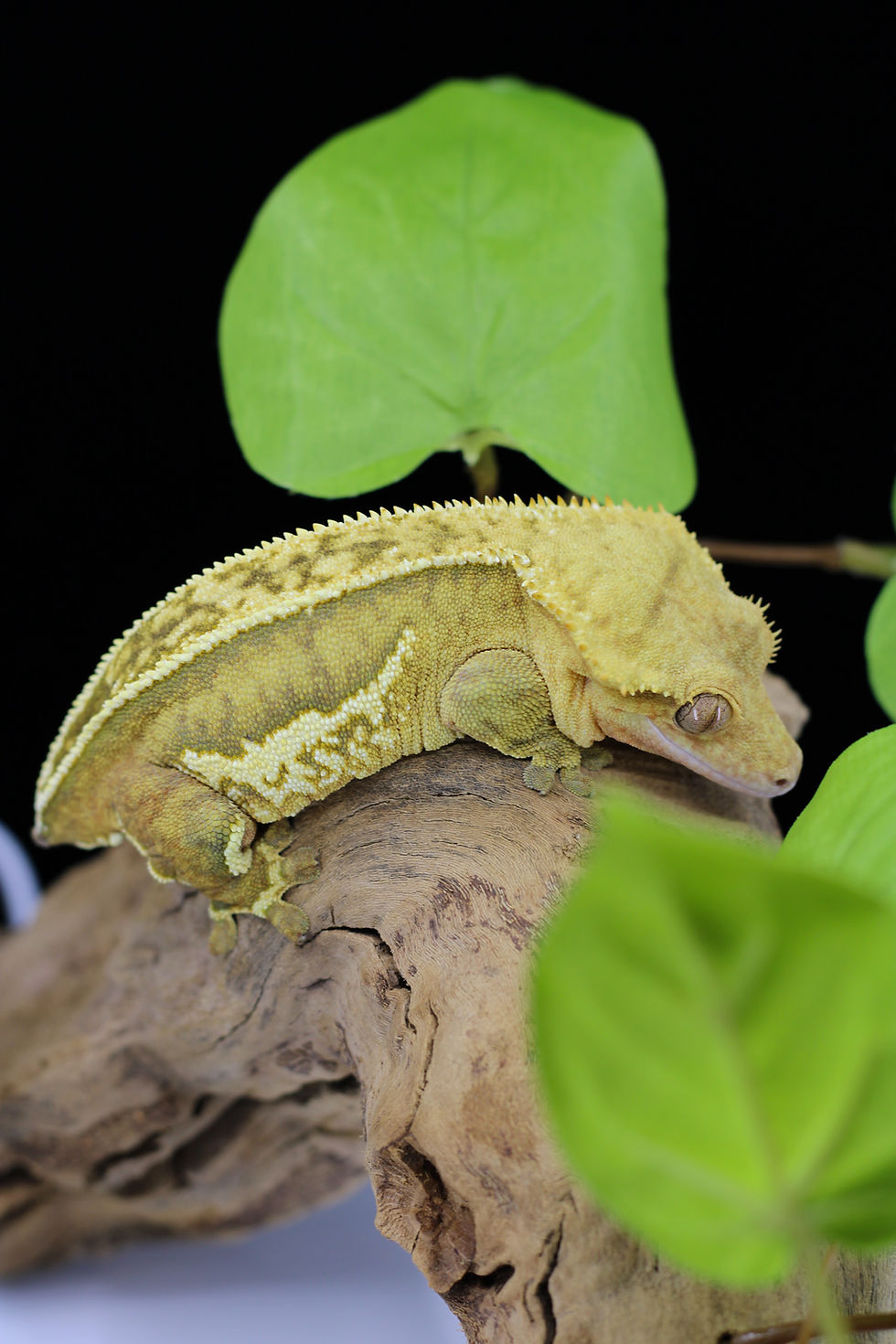Unlocking Crested Gecko Genetics Understanding Traits, Morphs, and Mendelian Principles
- Korey K-V Geckos
- Jul 6
- 5 min read
Crested geckos have become a favorite among reptile enthusiasts. They are not just loved for their striking looks but also for the intriguing genetics behind their unique traits and morphs. This guide will explore some simple crested gecko genetics in detail, providing practical examples of traits, discussing how some morphs follow Mendelian rules, and identifying the base colors that contribute to their appearance.
Understanding Genetics in Crested Geckos
Genetics is the study of how traits are passed from parents to offspring. In crested geckos, understanding genetics is vital for breeders aiming to create specific morphs. Traits are determined by alleles, which are different forms of a gene. The combination of alleles from both parents determines the observable characteristics, known as phenotypes, in the offspring.
This fascinating process of genetic inheritance follows established principles, rooted in the research of Gregor Mendel in the early 1900s. Mendelian genetics helps us break down how traits are passed down through generations.
Key Concepts of Mendelian Genetics
Mendelian genetics is built on a few essential principles:
Law of Segregation: Each parent contributes one allele for each trait during gamete formation, meaning alleles for a trait separate.
Law of Independent Assortment: Alleles for different traits are passed independently, leading to diverse combinations in the offspring.
Dominance: In cases where two alleles are present, one may dominate over the other. The dominant allele influences the phenotype, while the recessive one is expressed only when paired with another recessive allele.
Understanding these principles empowers breeders to predict the likelihood of certain traits appearing in future generations of crested geckos.

Examples of Genetic Traits in Crested Geckos
Crested geckos display a wide variety of traits that add to their appeal. Some noteworthy traits include:
Coloration in base color: Base coloration comes in various forms, such as, black, yellow, orange, red, olive, lavender, charcoal, and cold fusion. Some base colors are just a "sidestep" from their standard coloration base.
Here's a breakdown of some of the key base colors:
Black: A dominant base color, creating a dark appearance.
Yellow: Another dominant base color, resulting in a yellow body.
Red: A recessive but incompletely dominant color, with varying expression.
Orange: A polygenic base color, meaning it is influenced by multiple genes.
Olive: Also polygenic, resulting in a green-toned body.
Lavender: A polygenic and hypo melanistic base, exhibiting less black pigmentation.
Charcoal: A polygenic dark base phantom, sometimes with white fringing or a white belly.
Cold Fusion: A polygenic and hypo melanistic base, producing a bluish hue.
Brown: A common base color, often seen in wild-type geckos.
Tan: Another common base color.
Cream: A variation often seen in combination with other base colors, especially in patterned geckos.
Other colors: Crested geckos can also display pink, and various shades of brown, including dark brown.
Patterning: Patterns can range from solid to spotted or striped. For instance, a breeding pair of striped geckos can produce offspring with a 50% chance of inheriting stripe patterns.
Skin Texture: Some geckos have smooth skin, while others show distinct bumps and ridges. A tactile distinction can make handling them more interesting for their owners.
Combining these traits results in unique patterns, contributing to individualized aesthetics that many breeders aim for.

Predominant Morphs: Lilly White and Axanthic
Among the various morphs available, two prominent ones are the Lilly White and Axanthic morphs.
Lilly White: Known for its bright white coloration and high contrast. Two Lilly whites should not be paired together, as this is a lethal combination! Breeders can predict offspring from Lilly White parent; here are some examples;
Lilly white -to- Normal = 50% Lilly and 50% normal
Lilly white -to- Lilly white = 25% normal, 50% Lilly, and 25% Super Lilly (Lethal)
Lilly white to others: such as Cappuccino, Axanthic, and Sable;
Lilly white -to- Visual Axanthic = 50% Lilly white that are 100% Het Ax and 50% Het Axanthic
Lilly white -to- Sable = 25% Sable, 25% Lilly white, 25% Lilly white Sable, 25% Normal
Lilly white -to- Cappuccino = 25% Cappuccino, 25% Frappuccino, 25% Normal, 25% Lilly white.
Axanthic: This morph is distinguished by its muted gray or silver tones, resulting from a lack of yellow pigment. The Axanthic trait is recessive, requiring both parents to possess the gene for the characteristic to appear. Research indicates that with properly planned pairings, breeders can achieve this morph in several different ways. Some examples are;
Visual-to-Visual = 100% Visual offspring
Visual-to-Het = 50% visual and 50% will be 100% Het
Visual -to- Normal = All 100% Het offspring
100% Het -to- 100% Het = 25% Visual, 25% normal, 50% will be 100% Het
100% Het -to- Normal = 50% will be 100% Het, 50% Normal
When you breed 100% Het to another 100% Het all of your normal babies will be called "66% Het axanthic", because you don't know which one is normal and which one is 100% Het.
Both morphs highlight how genetics play a crucial role in the desirable traits of crested geckos.
Base Colors and Their Influence on Morphs
Crested geckos showcase a range of base colors that underpin various morphs. Understanding these base colors helps breeders create beautiful geckos.
Black: As the most common base color, it often serves as a foundation for diverse patterns and traits.
Red and Orange: These vibrant tones are popular among breeders. A pair of red geckos can produce 60-80% red offspring.
Yellow: This bright base color leads to lively patterns and is frequently seen in exotic morphs.
These base colors work together with dominant and recessive traits. By identifying these combinations, breeders can increase their chances of producing stunning offspring.

Practical Implications for Breeders
Grasping the principles of crested gecko genetics enriches the breeding process and fosters better care for these reptiles. By keeping track of genetic lines, breeders can avoid inbreeding, promoting healthy genetic diversity and more robust, visually striking geckos.
Furthermore, a solid understanding of Mendelian genetics results in more accurate predictions about offspring traits. This knowledge helps breeders make informed decisions, making their practices more efficient and satisfying for both them and their clients.
Embracing the Wonders of Genetics
Unlocking the complexities of crested gecko genetics opens an exciting realm for both enthusiasts and breeders. By understanding Mendelian principles, recognizing various traits and morphs, and appreciating the role of base colors, breeding these remarkable creatures becomes even more fulfilling.
Crested geckos beautifully illustrate how genetic principles result in stunning and varied appearances. As knowledge of gecko genetics continues to grow, breeders and enthusiasts alike can look forward to an exciting future in their herpetological endeavors.



Comments